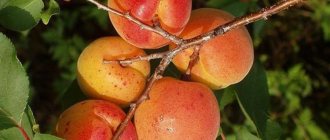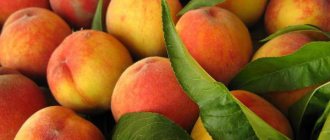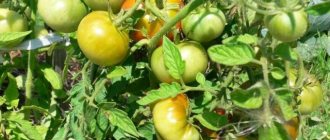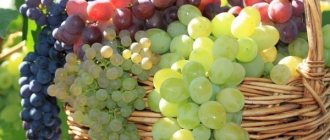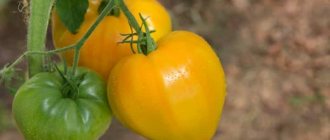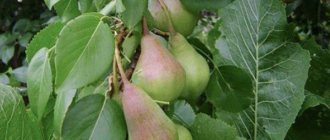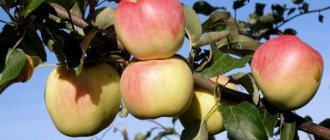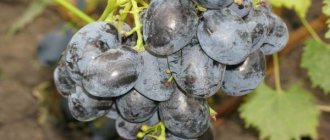Which early apricot varieties are the most productive?
Regardless of when apricots ripen, the gardener is always pleased to see large yields on the grown tree. Which early apricot varieties have consistently high fruiting?
- “Pineapple” (“Shalah”) ripens July 1-15. With proper care, the yield reaches 145 kg per tree. The fruits are large, up to 50 g. The shape is an irregular ball, slightly elongated. The seed is small and comes away from the fruit without any problems. The color of the skin is yellow. The color of the pulp is several tones darker than the skin. The pulp is juicy and fibrous. Recommended for fresh consumption; when preserved, it loses its taste, although it retains its shape.
- “Early Blush” is an early ripening apricot variety – June 10-15. Created by French scientists. Productivity from 0.5 centners and above. Apricots are oval, up to 70 grams, the skin is light orange, with a pink side. The pulp is loose, with a high juice content, good aroma, and orange color. The taste is pronounced, very sweet. Features: disease resistance, winter hardiness, transportability. The main disadvantage: the pit has an unpleasant taste with bitterness - you cannot seal the fruits in jars with it!
- “Melitopol early” ripens from the beginning of July. Tree 5-6 meters. Apricots 40-55 g, oval, wide. The color of the peel is yellow-orange, with a red “tan”. Bears fruit from 4-5 years. Productivity 30-50 kg/tree. The pulp is orange, not very dense, sweet, juicy. Resistant to bacterial cancer.
- "Leskora" is an early ripening apricot variety bred in the Czech Republic. Ripening is observed from June 15. It is easy to transport, resistant to cold and drought, and bears fruit every year. Productivity 40-50 kg/tree. On average, the fruits reach 50 g. But, if the fruits on the tree are properly rationed, individual specimens can weigh 100-150 g! The shape is elongated, the color of the peel is yellow-orange, with a heterogeneous blush. Surface without bumps. The taste is sweet and sour, the flesh is not very dense, orange in color, very juicy.
- “June” early apricot variety was obtained in Moldova. Ripening occurs from June 20 to 22. Self-sterile, apricots such as Kostyuzhensky and Krasnoshcheky are planted for pollination. It gives a harvest from the 4th year, the yield for the 8th-9th year is up to 32 kg per tree. Apricots are small, up to 30 grams, spherical, yellow, with one red “cheek”. The pulp is yellow-orange, juicy, sweet. The stone is small and easily separated from the pulp. The variety is resistant to cytospora.
Russian
Breeders' favorites include the following varieties:
- Champion of the North is a well-adapted variety for growing on difficult soils, but with sweet, pleasant-tasting fruits. Harvest 25 kg per tree.
- Favorite is a very unpretentious plant with dense, fleshy fruits, but some gardeners question its winter hardiness. Harvest 30 c/ha.
Apricot Augustine
Apricot Augustine is a mid-early, light-loving and shade-tolerant plant. Loves fertile, loose soil. Fruits with delicate, velvety skin and dense, creamy pulp. Flowering occurs in spring, ripens in the second half of August.
- The height of the tree is 15-20 meters.
- Winter-hardy.
- The structure is dense, with a slight reddishness on the skin.
- The weight of the fruit reaches 35 grams.
- Biochemical characteristics are high.
Aquarius
A very unpretentious plant obtained through pollination of the Lel variety. A powerful plant, a tall tree with a spreading, not dense crown. As a rule, it blooms very beautifully and profusely. It bears fruit with rounded fruits weighing 25-30 g. Their pulp is covered with delicate skin with a slight blush. The fruits are soft and tender, sweet and sour with a characteristic aroma.
Pineapple look
It is considered one of the best varieties of apricot - it is rightfully considered one of the sweetest and juiciest. It is characterized by high yield and resistance to frost. This variety has:
- pleasant taste
- suitable for drying
- has good transportability
The fruits have a pleasant taste, thick skin, and are quite heavy. They have a characteristic aroma. They are universal in use - they can be canned, used for desserts and eaten fresh. The downside is that the fruits have a short shelf life of 8-12 days and quickly fall off when ripe.
Apricot Masterpiece
Bred by breeders in the Nikitsky Botanical Garden. It has beautiful, golden-colored, blush-colored fruits that are velvety to the touch. The crop is distinguished by high yield and good frost resistance. The self-fertile harvest is early, ripens in mid-to-late July. Apricot Masterpiece has large fruits - fruit weight 60-80 g. The pulp is sweet, juicy and tender. The fruits are well transported.
Bush apricots
Siberian is a bush tree that is suitable for landscape design. The height of the plant is only 1.5-2.5 m. It is resistant to drought and winter frosts. Apricot is a bush variety with long, elongated leaves. The tree is light-loving and frost-resistant. Ripe fruits are medium-sized, yellowish-green with a burgundy side, and are not suitable for food.
Japanese apricot is a shrub with a decorative appearance. Incredibly beautiful during flowering, exudes a subtle pleasant aroma. The bush tree is actually a plum, a member of the rose family - widely used for landscape gardening. The plant thrives in areas with warm climates. Small fruits have a sour taste - they are used in processed form, and oil is produced by cold pressing.
Trees were once grown only in temperate climates. However, breeders have done their best to ensure that in the central zone of the Russian Federation the trees adapt to weather conditions and begin to bear fruit well. Now you can grow early, mid-early and late species in the middle zone.
Khabarovsk
A very productive, early-fruiting crop. The tall, five-meter tree has average resistance to frost. It can do without pollinators, but for a larger harvest, it is worth planting the “Snezhinsky” or “Amur” varieties nearby. The fruits are yellow-green, quite large, 35-45 g, their surface has small tubercles.
Red-cheeked
Known to breeders and gardeners. Suitable for successful cultivation in the vicinity of the capital and in the middle zone. Does not require careful care. It begins to bear fruit at 3-4 years. The tree is medium-sized, 4 meters tall; if formed in time, the crown of the plant will be spreading. It is unpretentious in feeding. Red-cheeked fruits weigh 50 g and are distinguished by a reddish barrel, sweet, tender, porous pulp. The large bone can be easily separated.
Red-cheeked son
A new variety that is known to leading breeders. The fruit was obtained by crossing Red-cheeked with Golden Sand. They have an excellent presentation and high transportability. A distinctive feature is the rapid growth of the tree, resistance to diseases and winter frosts in the middle zone. The plant bears large, dense fruits weighing 55-60 g; they taste sweet with sourness and a slight bitter aftertaste, giving the fruit a memorable piquancy. The fruits are good both fresh and for making preserves, jams, compotes and other preparations.
READ MORE: Tomato Uncle Stepa characteristics and description of the variety with photos
Kichiginsky
Bred from seed material of the Manchurian species. Entered into the State Register. It has an average ripening period and high yield. The variety has good winter hardiness. The harvest can be used universally - make jams, compotes, or eat fresh. The fruits of Kichiginseogo have a bright yellow color, good thickness, look very pleasant in appearance, taste sour-sweet, without bitterness. Average weight - 15 g. The inner stone is small in diameter, easily separated from the ripe pulp.
Triumph Northern
Bred by crossing the Transbaikal culture and Red-cheeked. It bears fruit for 4 years, the yield from one tree can be 60 kg. It is worth noting that the variety is characterized by harvest and lean seasons. The fruits are oval-round, with a thick, velvety skin. The color of the fruit is yellowish with a blurry pink blush.
Russian
Pleases with fruits 5 years after planting. It has high disease resistance and excellent yield. "Russian" is suitable for growing in the central zone. The fruits are quite large and heavy. Their weight reaches 50-70 grams. The uniform yellow color distinguishes this crop from other species.
Apricot varieties for the Moscow region and the middle zone must be grown, taking into account their characteristics. It is better to plant several trees in the garden with different fruiting periods. Then there will be a harvest on the plot all summer long.
Mid-late crop of Canadian selection. The plant has large fruits with fleshy fibrous pulp, bright orange in color with a rich, red blush. The fruits ripen at the end of July. Resistant to temperature changes. Tolerates frosts.
- fruit weight 70 g;
- not afraid of frost;
- yield 4;
- Suitable for all regions.
Apricot Kherson
The frost-resistant crop is popular for growing in the garden. Popular among gardeners for its pleasant taste. The fruits have thick skin and delicate pulp, medium weight and a characteristic aroma. Suitable for preparing winter preparations and eating fresh. Easily transported in small boxes.
- yield 5;
- disease resistance;
- average percentage of sugar content;
- pleasant taste.
Apricot Surprise
The culture was obtained from an elite seedling. Breeders crossed the apricot seedling with the Yantarny sample. The crown of the tree is slightly spreading. The fruits are heavy and ripen at the end of July. The color is orange-red with purple on the side. The skin is dense, pubescent, velvety.
- yield 5;
- resistance to cold;
- sweet and sour taste.
Apricot Round
Plant with ovoid fruits. The tree has a wide leaf and a medium crown density. Gardeners select the variety because of its excellent taste. The culture is able to withstand severe temperature changes and is resistant to frost.
Characteristics:
- yield 5;
- disease resistance;
- soft dense pulp.
Apricot Jubilee
The culture was obtained from collection samples. It is demanding on growing conditions and does not always produce the expected yield. Transported in boxes without problems. The pulp is sugary, with a pleasant characteristic aroma. The fruit is orange in color with a red crimson. The top of the fruit is slightly depressed.
- taste 5;
- versatility in application;
- oval middle bone;
- periodic yield.
The tree of this variety grows quite low, making it easy to harvest. Moreover, without shelter it can withstand frosts down to –30°C.
The fruits ripen round, orange in color, with excellent taste. Their flesh is rich yellow, tender and very juicy. The tree begins to bear fruit after 5-6 years of planting.
| Purpose | Harvest | Tree height (m) | Fruit weight (g) | Productivity (kg per tree) |
| Mid July | 3,5-4 | 60-65 | 80 | |
As a result of the work of breeders, nowadays southern fruits can be grown throughout most of Russia. For example, apricots grow well in the middle zone. The main thing is to observe the correct planting and care conditions, as well as choose a variety suitable for the region.
The main thing you should pay attention to when choosing an apricot variety for growing in central Russia is its winter hardiness.
This is the most important characteristic, since in regions other than the south there may be severe winters that heat-loving varieties will not survive.
READ MORE: How to fight aphids on an apple tree and how to treat them
Late spring and early autumn frosts also sometimes occur, which can damage young leaves and ripened fruits.
A little history
The creation of winter-hardy apricot varieties began in the 19th century by the famous scientist I.V. Michurin. Later, his work was continued by other Russian breeders. As a result, varieties of frost-resistant apricots have been created that are suitable for cultivation in the Middle Zone, such as:
- Edelweiss;
- Tsarsky;
- Yellow;
- Countess;
- Varangian;
- Aquarius;
- Delight;
- Alyosha.
Gardens of such apricots are still preserved in monasteries in the Central region. Such varieties were created by crossing southern apricots with Manchurian apricot, which has unpalatable fruits, but withstands harsh winters.
Ten best apricot varieties
The four favorites are followed by other varieties of apricot, no less popular among summer residents. The best of them meet all quality criteria: frost resistance, productivity, resistance to various kinds of ailments.
The top varieties included both vigorous and low-growing trees. Their description is given below:
- Apricot Augustine is distinguished by its tall growth, medium crown size and excellent fruits. The harvest ripens by the second half of August. The fruits are orange, weighing about 35 g, with creamy pulp.
- Chemal apricot bears small fruits weighing 25 g. The tree is frost-resistant and disease-resistant. The fruits are round orange, with a slight blush.
- Harcotte apricot comes from Canada. The fruits ripen in early July. Apricots are yellow, with a bright blush, very large, sometimes up to 60 g or more. The trees are productive.
- Apricot of the Harostar variety is another guest from Canada. It looks unusual: a very bright orange color with a rich blush over almost the entire surface. The pulp is orange and aromatic. It is commercially profitable to grow apricots of this variety - the fruits stay on the tree for a long time, can easily be transported over long distances, are stored for a long time, and do not crack.
- Amur early is suitable for both professional and amateur cultivation. Sunny, beautiful fruit color, weighing about 35 g.
- The favorite is a dwarf variety, barely reaching a height of 3 m. It bears fruits weighing 30 g, round and shiny, yellow-orange with a blush.
- Apricot variety Darina from the Czech Republic. Fruits moderately but regularly. Even frost-resistant varieties rarely withstand spring frosts, but the buds of this apricot can withstand even less bad weather. The fruits are very large, bright and sweet.
- Apricot Viking lives up to its name and can withstand the lowest temperatures. Fruits weigh 30 g, bright yellow.
- The Beltyaevsky variety has average cold resistance, but produces abundant harvests of very tasty fruits. Apricots ripen towards the end of August.
- Lyuchak Chemalsky is a variety bred in Chemal. Excellent winter hardiness, strong growth, small fruits 18 - 20 g, distinguished by a pleasant sweet taste.
Apricot Lyuchak Chemalsky has a pleasant sweet taste
Pests and diseases
High humidity provokes the formation of fungal infections, and also contributes to the development of diseases such as clasterosporiasis, moniliosis, and verticillosis.
As a preventative measure, apricots are annually pruned, bleached and sprayed with fungicides. Aphids settle on the reverse sides of leaves, sucking liquid from them. The shoots lack nutrition and the trees develop poorly.
In August, codling moths actively eat ripening fruits and spend the winter in the ground near the trunk or in the lower parts of trees under the bark.
Leaf rollers feed on buds and leaves, which also harms the full development of apricots.
Characteristics
Early apricot Delight has won the recognition of gardeners in many regions of the Russian Federation. And this is not surprising, because it has quite good characteristics.
Drought resistance, winter hardiness
Apricot Delight is characterized as a frost-resistant variety, therefore suitable for cultivation in areas with cool winters. This crop is not afraid of drought either. However, you still need to water the tree 1-2 times a month in the warm season.
Pollinators of apricot Delight
The early apricot variety Delight is self-sterile. This suggests that it will need pollinating trees to produce good yields. This role can be played by other varieties of this crop, the flowering period of which coincides with Delight, for example, Manchurian and Kichiginsky.
Flowering period and ripening time
Delight is an early ripening apricot variety. Already in early May, the tree is covered with white and pink flowers, and at the end of June you can get the first ripe fruits.
Ripe apricots appear in early July
Productivity, fruiting
Fruiting time is in July. The first apricots appear in the 3rd year. Subsequently, the tree bears fruit every summer throughout its life (about 30 years).
The average yield of the Delight apricot is 15 kg per adult tree. The reason for its decrease can be sudden changes in temperature, causing kidney damage, high humidity, improper care and tree diseases.
The yield of the variety is about 15 kg per tree
Area of application of fruits
Apricots have good taste, which makes it possible to consume them raw and use them for whole-fruit canning, in the process of making preserves, compotes and jellies.
In addition, dried fruits are made from apricots:
- dried apricots (dried pitted apricot halves);
- apricots (dried whole fruits with seeds);
- kaisu (dried whole fruits without seeds);
- ashtak (dried whole fruits without seeds, but with kernels embedded in them).
Apricots are used fresh or processed
Resistance to diseases and pests
The Delight variety is resistant to many diseases. However, high humidity and improper care can provoke the appearance of fungal diseases and pest attacks. To prevent such troubles, trees are sprayed with insecticidal and antifungal drugs.
Advantages and disadvantages
The popularity of the Delight apricot is explained by the inherent advantages of this variety. It also has minor drawbacks, but with the right approach they can be eliminated.
One of the main advantages of the culture is the good taste of the fruits.
- large size and good taste of fruits;
- high productivity;
- drought resistance and ability to tolerate low temperatures;
- disease resistance;
- versatility of fruit use.
- self-sterility of the variety, which necessitates the presence of pollinating trees;
- tendency of fruits to fall;
- short shelf life of ripe apricots.
Subsequent care of the crop
Caring for the crop involves the following activities:
- Watering. Apricot Delight is characterized as a drought-resistant variety, so it is not necessary to irrigate it too often. One abundant watering once a month and autumn watering before wintering will be enough.
- Feeding. They begin to feed the apricot Delight in the second year of life. Before the start of the growing season, fertilizers with nitrogen are applied. Before flowering, the tree is fed with potassium fertilizers, and in the fall - with mineral fertilizers, which include potassium and phosphorus.
- Removing weeds and loosening the soil. It is recommended to remove weeds as they appear. The soil is loosened after each watering. If it is covered with mulch, there is no need for loosening.
- Trimming. Apricot Delight is pruned twice a year. In the spring, sanitary pruning is carried out, during which dry and damaged branches are removed, and in the fall, formative pruning is carried out, the purpose of which is to thin out the crown.
- Disease prevention. Before the growing season begins, the tree is treated with fungicides and insecticides.
In spring and autumn, it is recommended to whitewash the tree trunk to prevent damage. The whitewashing agent can be purchased ready-made in the store or prepared independently by adding copper sulfate to an aqueous solution of quicklime.
Feed the tree 3 times a year
Selecting a location and planting an apricot
We choose a place for this plant that is protected from the winds and well lit by the sun. It is better if the site is on a hill to prevent contact of roots with groundwater.
In the lowlands, apricots are planted in a specially created hill so that groundwater is not close to the roots
The compatibility of apricot with other trees should be taken into account. Pome trees (apple, pear, quince) and stone fruits (cherries, sweet cherries, plums, cherry plums) will not affect it if they grow at a distance of 4–5 m; berry bushes (raspberries, currants) are best placed further away. An apricot will not get along next to a peach.
In the mid-80s of the last century, my mother planted four walnuts, only one of which sprouted. At the time, she had no idea how big the tree would be or how it would affect other plants. The seedling was moved to the garden, closer to the fence, and about six meters away, an apricot was planted two years earlier. It soon became clear that the nut was suppressing everything within its reach. And when he stretched higher than the apricot, dramatic changes began to occur to the latter. The number of fruits began to decrease, the trunk deviated, and the branches stretched away from the nut. The apricot began to wither, dry out, and had to be uprooted.
It is better to plant the plant in early spring, before the sap begins to flow. This can be done at the beginning of autumn, but in central Russia or the Moscow region, the seedlings will not have time to take root well and ripen before the onset of cold weather.
It is better to prepare the pit in the fall. Until spring, the earth will shrink, so the root collar will not deepen, which is extremely undesirable for any tree.
Landing Features:
- Apricot prefers fertile, loose soil. Heavy clay soil can be improved by adding sand and peat (1:1:1). The width of the hole should be 60–70 cm, depth - 70–80 cm. To create drainage, pour a layer of crushed stone or broken brick (7–10 cm), on top of it - a mound of a mixture of garden soil and compost or rotted manure (2:1) with the addition of complex mineral fertilizers (according to instructions).
- Approximately 15–20 cm from the center of the hole we install a stake 50–60 cm high to secure the seedling.
- We inspect the roots of the plant; they should be alive, elastic, light brown. We cut out broken or damaged ones with pruning shears. For better survival, before planting, place the plant in water with a root formation stimulator (according to the instructions) for several hours.
- We place the seedling in the center of the hole, straighten the roots and fill it with some soil. Lightly crush it and pour out two buckets of water.
- After absorption, pour the remaining soil under the seedling, compact it and make a side of the hole.
- If you have a plant with a closed root system, then remove it from the container with a lump of earth, place it in a hole, cover it with soil and water it.
- We make sure that the root collar is not buried. It should be located at a height of 3–5 cm from the soil surface.
- We tie the tree to a support and mulch the ground.
Early varieties of apricots
They provide the opportunity to enjoy tasty and healthy fruits where the summer is very short. But plants with early ripening periods are very sensitive to temperature changes and are very afraid of frost. Among the variety of varieties presented, experienced gardeners and summer residents have identified the most worthy of attention and unpretentious in cultivation.
Apricot Lel is able to please with the first harvest three years after planting the young plant. The crown is very neat in appearance, not spreading, and requires minimal shaping. The height of the tree reaches 3 meters. Very disease resistant, stable yield.
The weight of each fruit of the Lel variety is about 20 grams. At ripeness, the color of apricot becomes rich yellow, closer to orange. The aroma is classic.
The shape of the fruits is slightly flattened. Thanks to the durable skin, they tolerate transportation well and are stored well. The pit is very easy to remove. Suitable for all types of processing and fresh consumption.
Fruiting of this variety begins only 5 years after planting a young tree. Resistance to diseases is high, tolerates light frosts. The tree is not tall, which makes caring for it much easier.
The crown is very compact. Productivity is good. The fruits are characterized by classic taste and aroma, medium size. When ripe they are yellow in color with a few red dots on the skin.
- freezing
- conservation
- making juices
- fresh consumption
Melitopol early
Another excellent low-growing variety, which is still capable of producing a lot of yield. High disease resistance and minimal care are the main advantages of this apricot. In addition, it can easily tolerate light spring frosts.
It begins to bear fruit after three years. The fruits of Melitopol early grow large, thin-skinned, with a medium stone, which is easily separated from the pulp. There are no hard fibers, the pulp is homogeneous.
It is used mainly for fresh consumption; it is not suitable for processing or canning.
Despite the fact that this variety is classified as an early variety, full ripening of the fruit occurs in August. It is precisely because of this feature that it is better not to grow it in cold climates. The tree itself is very tall, spreading, its height reaches 4 meters.
Productivity and disease resistance are high. The weight of one fruit is about 23 grams. A ripe apricot has a rich orange or yellow skin with a beautiful blush.
The thick crust ensures long storage: the fruits can easily lie for about two weeks in a cool place. They can be eaten fresh or canned in any way.
A very worthy variety that tolerates frost well and has good immunity to major diseases. The productivity is very high. The fruits appear 5 years after planting.
The weight of one fruit reaches 93 grams. The stone is easily separated from the pleasant-tasting pulp, and the skin is medium thick. The taste is high, the aroma is classic.
Large apricots cannot help but attract attention; you immediately want to eat them. That is why Lescore is grown mainly for sale and fresh consumption.
Advantages and disadvantages of the variety
The main positive qualities of the Delight apricot include:
- large fruit size;
- good yield;
- high winter hardiness;
- good resistance to drought;
- this varietal apricot is resistant to fungal diseases and pests;
- high marketability and taste qualities of ripe apricots;
- versatility of the harvested crop.
The main disadvantage of this variety is its low self-fertility, so several pollinator trees have to be planted next to it.
And yet, the Vostorg apricot is one of the most popular varieties zoned for cultivation in Siberia, the Urals, the Moscow region and other regions with a similar climate. Since it does not freeze in cold winters, and the taste of the fruit is no worse than that of a similar fruit crop grown in the south, it becomes clear why gardeners are so fond of this apricot.
Features of planting and growing
It is better to start planting closer to mid-April, when the soil has warmed up sufficiently and the risk of return frosts has passed. If in the region a drop in temperature below 0 is observed in early May, then during the dangerous period the tree should be covered with a plastic bag. The place for the apricot is sunny, protected from cold winds and drafts. If the area is swampy, then a high embankment is made for planting the Russian. The proximity to raspberries and currants is considered unlucky, and the crop should not be placed where other stone fruits have recently grown. How to plant:
- In the fall, you should dig a hole 75x75 cm deep and wide, mix the discarded soil with humus, compost and ash, add a little mineral mixture. The amount of fertilizer is regulated depending on the initial condition of the soil; it should not be oversaturated either.
- If necessary, a drainage layer (pebbles, broken stone, etc.) is placed at the bottom of the hole, ¼ of the prepared soil mixture is poured on top, the rest is left for spring to fill the seedling.
- In the spring, you need to drive a peg in the middle of the hole, place a seedling next to it and fill it up so that the root collar is 50 mm above the ground level.
- Make an earthen roll around the apricot, pour at least 2 buckets of water under the tree in several stages (carefully, without exposing the roots). The stem must be tied to a peg.
If desired, you can shorten the shoots a little, but the main thing is that until the apricot gets stronger, it needs to be watered 2 or 3 times a month. Each tree should receive about 15 liters of water. During rainy periods, there is no need for additional moisture; on the contrary, you need to loosen the soil so that the moisture does not stagnate. After the apricot begins to bear fruit, watering is permissible only until July.
In September, you need to scatter ash in the tree trunk circle and do a shallow digging. Once every 3 or 4 years, you can make several holes around the trunk and pour a bucket of rotted manure or compost into them. If necessary, you can feed the apricot in June (leaf by leaf) with a solution of complex fertilizer. From mid-summer it is strictly forbidden to use nitrogen fertilizers; it is better to use phosphorus-potassium mixtures.
Pruning and preparation for winter
In the spring (a month before the start of the growing season), thinning pruning is carried out, weak and not overwintered branches are cut out, as well as fruit branches older than 3 years, as they will give a small harvest. In June, the thinning operation can be repeated (shorten young shoots by a third, remove excess ones), but only if the season is not dry. In mid-October, you need to remove all weak and diseased branches, and cover the cut areas with garden varnish.
The tree should be covered only before fruiting begins; the trunk should be tied with spruce branches and covered with non-woven material on top. Preparation for wintering an adult tree involves removing plant debris and weeds from the tree trunk. It is not advisable to hill up the trunk, since winter thaws can cause the root collar to damp out, which is more dangerous than freezing of the branches.
The Russian is popular among gardeners in the Moscow region, where it shows excellent results. The variety has been known in the middle zone for more than 30 years; during all this time, not a single case has been recorded in which it was severely affected by diseases, pests, or produced too little yield. For more successful cultivation, professionals advise protecting the apricot trunk from rodents by laying spruce branches around it, and also whitewashing the tree in early March.
Maria
Over the course of 15 years, I managed to try 6 different varieties of apricot, which have excellent winter hardiness; I liked the Russian one the most. Its fruits, unlike others, are large and very sweet and aromatic. The taste, as I noticed, is slightly lost after drying and heat treatment, but remains good. For 3 years I covered the trunk, for the fourth year it was not possible to get out to the dacha in the fall, and in the spring the tree bloomed. To prevent the tree from becoming depleted, I removed 90% of the flowers, and in the second and third seasons I cut off 50% of the greens. Now I don’t carry out normalization; the tree is 8 years old and produces 40 kg of fruit per year.
Alexander
The Russian first attracted me because the tree is winter-hardy, and then I fell in love with this variety for the taste of the fruit, and my grandchildren adore them. The tree practically does not produce root shoots, but the crown grows very quickly, I do pruning annually. Once I experimented and skipped the spring-autumn haircut, this immediately had a bad effect on the yield. Initially, the tree grew in an open area, suffered from winds in winter and spring, the branches froze, a brick fence was installed on the north side, the problem was solved.
Planting
Before planting, it is extremely important to choose healthy seedlings that can actively bear fruit; this is best done in specialized stores or nurseries. Before purchasing, they should be inspected to ensure their high winter hardiness; the root system must be carefully examined - the roots must be strong and healthy
The planting period varies: in the south, planting is possible in spring and autumn, and in the middle zone - only in spring.
The landing site must meet a number of requirements:
- the seedling must receive enough sunlight;
- Groundwater should not flow nearby, as it poses a great danger to the roots;
- the most suitable soil for this variety consists of sand, clay, peat in equal quantities;
- soil acidity should be low, ideally neutral, acidity is reduced by adding dolomite flour;
- the earthen layer must allow air and water to pass through unhindered;
- complete drainage must be done;
- the optimal distance between seedlings is 4 m.
The depth and diameter of the planting hole should be 70 cm; the worse the soil in terms of its characteristics, the larger the size of the hole should be. It is necessary to place the seedling in the hole, carefully straightening the root system, the root collar should partially come out. The seedling needs to be sprinkled with a layer of fertile soil.
Requirements for the site for planting
Growing “Vostorg” apricots in the conditions of amateur home gardening requires a competent selection of the site and high-quality preparation of it for planting:
- the soil on the site should be as loose as possible, and also easily permeable to moisture and air, with neutral or slightly alkaline indicators;
- optimal for growing apricots are soils consisting of three components in the form of clay, peat and sand, mixed in equal proportions;
- on cultivated soils with high fertility rates, the size and depth of the planting hole should be 65-70 cm;
- on heavy and infertile soils, the standard dimensions of the planting pit cannot be less than 1 x 1 m;
- a prerequisite is the low occurrence of groundwater, as well as the creation of high-quality drainage in the area allocated for growing fruit crops.
Apricot “Vostorg” deservedly received the highest rating for taste and appearance. According to gardeners, the plants have excellent winter hardiness, excellent taste and visual attractiveness of the fruits. The variety is characterized by high yield. The fruits can be assessed as very large, excellent taste, bright yellow in color, with a delicate crimson blush. Apricot seedlings of this variety grafted onto the rootstock of Manchurian apricot show very good results.
Apricot delight early variety description – Garden and vegetable garden
The description of the apricot variety “Vostorg” is known today to many domestic amateur gardeners.
The variety is quite popular due to its large number of advantages and has earned numerous positive reviews in most regions of our country.
Among northern and winter-hardy apricots, this variety is currently one of the best and most promising.
Apricot Delight or choose the appropriate variety
Apricot is a demanding crop. In cold regions, including Russia, cold winters freeze out apricot trees, leaving them no chance of survival.
Breeders have done a great job of developing frost-resistant varieties for cultivation in cold climates.
Winter hardiness is a determining criterion when choosing an apricot variety for planting in Russia
For Russia, winter hardiness is the determining criterion when choosing an apricot variety for planting.
Promising Delight
Apricot variety Vostorg is the most promising for cultivation in Russia. The creators of Delight are F.M.Gasimov and K.K.Mulloyanov.
The tree reaches 3 m in height with a crown diameter of 4.5 m. It is very frost-resistant and easily tolerates the coldest winters. The fruits are round, yellow with a blush. The average weight of apricots is 22 g. The thin skin hides juicy, bright orange pulp. Delight resists frost well, but unexpected thaws and temperature changes can undermine the well-being of apricots and lead to low yields
It is important to prepare the tree for winter. Another unfavorable factor is spring frosts.
It is suitable for cultivation in central Russia, but for growth and good yield it will require care and maintenance.
Harsh Cupid
Apricot Amur was developed in 1949.
The characteristics of the variety have brought it to the forefront among the best varieties of apricot trees in Russia.
The variety was bred in the Far East and is recommended for cultivation in this region.
- The trees are medium-sized, but with a luxurious dense crown. The bark on the trunk is dark brown, the branches have a grayish tint. The leaves are large, slightly pointed, matte, rich green. The petioles are reddish, and the flowers are large, pale pink.
- The trees are winter-hardy, but can freeze if they were planted in damp lowlands.
- The fruits weigh on average 26 g, but can be larger - up to 32 g. The fruits are round, slightly elongated towards the top, sunny yellow with a bright, cheerful blush. The orange pulp is dense and juicy, sweet with an interesting sour note. The fruits tolerate transportation well and are stored for a long time, do not crack from wet weather, and ripen in the first half of August.
Winter hardiness and preparation for winter
The winter hardiness of the “Vostorg” apricot can be negatively affected by unfavorable factors in the form of thaws and sudden temperature changes. Such conditions provoke damage to flower buds and significantly reduce yields, and can also cause irregular fruiting.
It is especially important to take care of the problem-free wintering of young fruit plants, which are characterized by fairly strong and prolonged development, which does not allow them to adequately prepare for frost. The result is freezing of non-lignified shoots
To reduce the risk of damage and sunburn in winter and spring, it is necessary to whiten the trunk and the base of the skeletal branches in the fall. For whitewashing, it is recommended to use a lime solution with the addition of copper sulfate and flour paste. It is allowed to use water-based paint or ready-made special garden whitewash
It is also very important to carry out sanitary pruning in the autumn and provide plants with protection from rodents.
Characteristics of the Favorit variety
Favorite is a very common tree due to its qualities, due to which it greatly outperforms other varieties. It has quite a lot of advantages, but few disadvantages, but everyone who wants to plant this variety on their plot should know about them.
Drought resistance, frost resistance
The variety is classified as a frost- and drought-resistant tree. The favorite is able to withstand a drop in the average daily temperature in winter to -15ºС. At this temperature, no noticeable changes are observed on the bark.
However, it is very important to understand that good frost resistance in winter does not indicate unpretentiousness to the temperature regime during the flowering period. The favorite is difficult to tolerate sharp drops in temperature at the beginning of spring, as well as heavy precipitation during this period.
However, with the exception of this period, the Favorit variety is distinguished by its relative unpretentiousness and drought resistance in the summer: even without timely watering in dry summers, the tree is able to develop normally, however, in order for the fruits to set and form normally, periodic watering is still necessary for the apricot, while To preserve moisture in the soil, experts advise additional mulching of the tree trunk area in regions with a hot climate.
Apricot pollinators
The main advantage of Favorit is that the tree bears fruit well without additional pollinators (it has high self-fertility).
Did you know? The name "dried apricot" applies only to dry, pitted apricots cut in half. The whole dry fruit is called “kaisa”.
This is a very important factor for the cool center of Russia, where the risk of return frosts is very noticeable, and therefore such an additional condition as outside pollinators reduces the prospect of being left without a harvest.
By the way, in terms of winter hardiness, Favorite is also significantly ahead of most of its relatives. However, if there is an opportunity to plant varieties such as Tsarsky, Monastyrsky and Lel nearby, then the yield will increase very significantly.
Productivity of the variety
As already noted above, the yield of this species is not the main trump card. However, it cannot be said that very little fruit grows. In a good harvest year, you can get up to 5 kg of large apricots from one branch. On average, a whole tree produces about 20 kg per season.
Area of application of fruits
The berries have relatively good shelf life and are not prone to radical damage during transportation. Apricots of this variety are universal: they can be consumed freshly picked or prepared into delicious jams, confitures, preserves and compotes.
Perfect for drying and canning. Fresh apricots also make an excellent filling for pies and other baked goods. Slightly overripe fruits can be used to make homemade wines and liqueurs.
Ripe fruits contain a large amount of sugar and are also incredibly rich in potassium (100 g of product contains more than 350 mg).
Resistance to diseases and pests
The favorite is classified as an unpretentious tree that does not require special protection due to its high resistance to diseases and pests. However, the variety is moderately resistant to cluster blight, and can also be slightly affected by aphids (up to 1%).
Did you know? A unique feature of aphids is their ability to give birth to pregnant offspring.
General information about culture
Frost-resistant varieties of apricot can now be found in garden plots in many regions of Russia, since it is quite understandable that gardeners want to collect the tasty and sweet fruits of this stone fruit in their garden, and not wait for them to appear for sale in local supermarkets.
The new frost-resistant apricot Vostorg, which appeared not so long ago, was bred by breeders F. M. Gasimov and K. K. Mulloyanov. They planted a Piquant apricot seedling, which pollinated freely, resulting in a new species.
There are many frost-resistant apricot varieties (except Vostorg) that can be grown in regions with short summers and cold winters:
- Lel;
- Northern Triumph;
- Black and Honey Apricot.
These winter-hardy varieties of apricots also deserve the attention of gardeners living in the northern regions, as their fruits are tasty and sweet.
Important! Most varieties of apricots have a significant drawback - their self-fertility is quite low, so for better cross-pollination, several different varieties of these stone fruit crops are planted nearby.
Features of care
Apricots are prone to damping off, so attempts to “insulate” the trunk for the winter by wrapping it in straw and burlap do more harm than good. Another feature of this plant is that it does not shed excess ovary like an apple or plum tree. A lot of fruits develop, which can lead to branches breaking off and weakening the plant. Regulate the amount of ovary by pruning.
Feeding
For the first 3-4 years, the apricot will have enough nutrients added during planting. After this, once every three years it is necessary to add organic matter, well-rotted manure (4 kg/m2) or compost (5–6 kg/m2). Mineral fertilizers are added annually. In spring, nitrogen-containing fertilizers (at a rate of 30–40 g/m2) are divided into three parts: before flowering, after it and when the ovary is the size of a pea. Potassium salt (40–60 g/m2) is also applied in three doses: during the ripening period and then with a break of a month, embedding the fertilizer in shallow grooves. Apricots need superphosphate before flowering, after it and when the crop is harvested (25–30 g/m2).
Recent posts 5 plants that you can plant in the dampest areas of your garden How I managed to grow a natural sugar substitute - steviaBeautiful but poisonous plants that should not be planted in the garden if you have children and animals
The lack of microelements is judged by the condition of the plant. Their deficiency can be compensated for by foliar feeding.
Harvesting and storage
Harvesting is best done in dry, clear weather, in three to five stages. Apricots are picked, breaking off from the stalks, and carefully placed in containers. Harvest in the morning or after sunset. Apricots picked in cold or hot weather lose their taste and aroma, and those picked wet (after rain) are poorly stored.
For storage, you need to pick slightly unripe fruits - they will ripen at home and tolerate transportation well. Fully ripe apricots should be eaten or processed immediately, because they can be used to prepare many different delicacies.
Although apricots cannot be stored for long, slightly unripe fruits, collected in dry weather and placed in a wooden or plastic box, can be stored in the cellar for up to 3-4 weeks
Red-cheeked is an excellent, time-tested variety of apricot. It is distinguished by its high yield and excellent taste, and in addition, it will decorate any garden with its color, while being absolutely unpretentious in care.

